The multi-axis PCB drilling machine market is expected to grow from USD 374.6 million in 2025 to USD 677.2 million by 2035, with a CAGR of 6.1%. The market experiences steady growth with significant breakpoints that reflect changes in demand and technological advancements. From 2025 to 2030, the market gradually increases from USD 278.6 million to USD 374.6 million. This period represents a steady uptick driven by the growing demand for precision PCB drilling machines in electronics manufacturing, particularly for advanced printed circuit boards (PCBs) used in industries such as consumer electronics, automotive, and telecommunications.
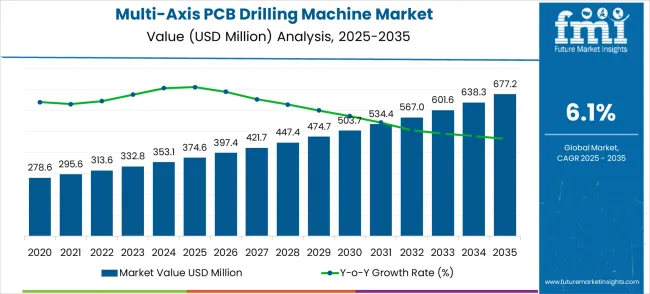
The first major breakpoint occurs between 2030 and 2031, when the market rises from USD 374.6 million to USD 397.4 million. This surge is driven by advancements in multi-axis technology that enhance drilling accuracy, speed, and efficiency. Further acceleration is observed between 2032 and 2035, as the market progresses from USD 421.7 million to USD 677.2 million. This phase of growth is fueled by the increasing adoption of smart manufacturing practices, the rise of IoT-enabled devices, and the expansion of the 5G ecosystem, all of which require more intricate and precise PCB designs. As these industries evolve, the demand for high-performance drilling machines grows, marking the second major breakpoint in 2032. The final stretch from 2033 to 2035 sees rapid market expansion, driven by industry-wide shifts toward automation and the rising complexity of PCB designs.
| Metric | Value |
|---|---|
| Estimated Value in (2025E) | USD 374.6 million |
| Forecast Value in (2035F) | USD 677.2 million |
| Forecast CAGR (2025 to 2035) | 6.1% |
The multi-axis PCB drilling machine market plays a crucial role in the electronics manufacturing and PCB production industries, driven by the growing demand for precision and high-density printed circuit boards (PCBs). In the electronics manufacturing market, multi-axis PCB drilling machines represent around 4-6% of the total market share. These machines are essential in producing complex and precise PCBs used in consumer electronics, medical devices, and industrial systems. The increasing miniaturization and complexity of PCBs across various devices, such as smartphones and laptops, has significantly boosted the demand for advanced drilling machines. Within the PCB market, these machines account for approximately 5-7%, as they are integral to the fabrication of multi-layered, high-performance circuit boards needed for modern electronic products.
In the automation and robotics market, multi-axis PCB drilling machines contribute about 3-5%, reflecting their role in automating production lines for PCB manufacturing. The machines help improve efficiency, accuracy, and throughput in high-volume production environments. In the consumer electronics market, they represent around 6-8%, driven by the increasing demand for small, high-functioning electronics that require complex, densely packed PCBs. In the automotive electronics market, multi-axis PCB drilling machines account for approximately 2-4%. As the automotive industry incorporates more electronic systems into vehicles, such as sensors and control modules, the need for high-precision PCB drilling continues to rise.
Market expansion is being supported by the increasing global demand for advanced electronics and the corresponding need for high-precision manufacturing equipment that can maintain accuracy and speed while enabling complex drilling patterns across various PCB applications. Modern electronics manufacturers are increasingly focused on implementing drilling solutions that can reduce production time, minimize material waste, and provide consistent quality in high-density PCB products. Multi-axis PCB drilling machines' proven ability to deliver enhanced precision, improved throughput capabilities, and versatile drilling applications make them essential equipment for contemporary electronics manufacturing and production optimization solutions.
The growing emphasis on miniaturization and circuit density is driving demand for multi-axis PCB drilling machines that can support complex drilling requirements, reduce setup time, and enable year-round production of advanced electronic components. Electronics processors' preference for equipment that combines precision capabilities with operational efficiency and cost-effectiveness is creating opportunities for innovative multi-axis drilling implementations. The rising influence of 5G technology and IoT device trends is also contributing to increased adoption of multi-axis drilling machines that can provide advanced manufacturing solutions without compromising drilling accuracy or production speed.
The market is segmented by classification, application, and region. By classification, the market is divided into two axes, six axis, and others. Based on application, the market is categorized into communication, computers & servers, consumer electronics, automotive electronics, and others. Regionally, the market is divided into North America, Europe, East Asia, South Asia & Pacific, Latin America, and the Middle East & Africa.
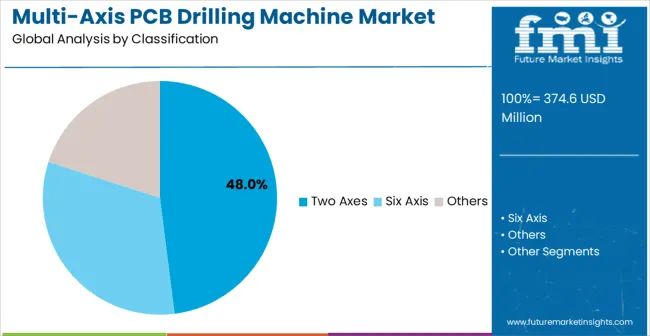
The two axes segment is projected to account for 48.0% of the multi-axis PCB drilling machine market in 2025, reaffirming its position as the leading classification category. Electronics manufacturers increasingly utilize two axes drilling machines for their superior cost-effectiveness, proven reliability, and convenience in standard PCB production applications across communication devices, consumer electronics, and automotive components. Two axes drilling technology's established processing capabilities and consistent quality output directly address the industrial requirements for reliable hole precision and operational efficiency in medium-scale electronics production.
This classification segment forms the foundation of modern PCB manufacturing operations, as it represents the equipment with the greatest versatility and established market demand across multiple electronics categories and manufacturing applications. Manufacturer investments in enhanced two axes drilling technologies and precision control systems continue to strengthen adoption among electronics producers. With companies prioritizing consistent drilling quality and proven performance, two axes machines align with both operational efficiency objectives and production reliability preferences, making them the central component of comprehensive PCB manufacturing strategies.
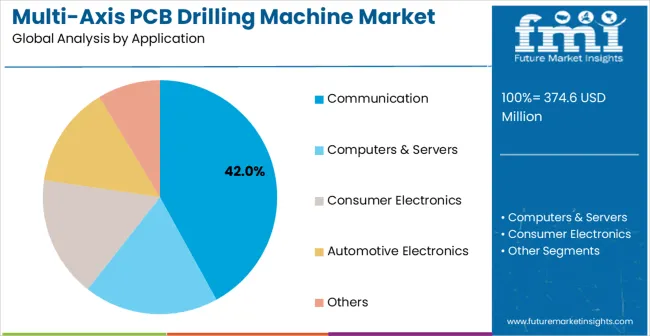
Communication applications are projected to represent 42.0% of multi-axis PCB drilling machine demand in 2025, underscoring their critical role as the primary industrial consumers of advanced drilling equipment for telecommunications and networking device production. Communication equipment manufacturers prefer multi-axis drilling machines for their precision capabilities, high-speed operation, and ability to handle complex circuit patterns while reducing manufacturing complexity and improving production throughput. Positioned as essential equipment for modern communication device manufacturing, multi-axis drilling machines offer both operational advantages and quality benefits.
The segment is supported by continuous innovation in 5G technology development and the growing availability of specialized drilling capabilities that enable premium PCB production with enhanced signal integrity and miniaturization requirements. Communication manufacturers are investing in advanced drilling systems to support high-volume production and quality assurance for next-generation networking equipment. As 5G deployment becomes more prevalent and communication device complexity increases, communication applications will continue to dominate the end-user market while supporting advanced drilling utilization and manufacturing innovation strategies.
The multi-axis PCB drilling machine market is advancing rapidly due to increasing demand for miniaturized electronics and growing adoption of advanced manufacturing equipment that provides enhanced precision and throughput capabilities across diverse PCB applications. The market faces challenges, including high initial equipment costs, technical skill requirements for operation, and the need for regular maintenance and calibration investments. Innovation in automation technologies and AI-integrated drilling systems continues to influence product development and market expansion patterns.
The growing adoption of six-axis and multi-axis drilling systems is enabling electronics manufacturers to produce complex PCB designs with superior hole quality, enhanced drilling speed, and advanced pattern capabilities. Advanced drilling systems provide improved manufacturing flexibility while allowing more efficient production and consistent output across various PCB types and applications. Manufacturers are increasingly recognizing the competitive advantages of advanced drilling capabilities for product differentiation and premium market positioning in high-tech electronics segments.
Modern multi-axis PCB drilling machine producers are incorporating artificial intelligence and automated control systems to enhance drilling precision, optimize production efficiency, and ensure consistent quality delivery to electronics manufacturers. These technologies improve manufacturing productivity while enabling new applications, including adaptive drilling parameters and real-time quality monitoring. Advanced automation integration also allows manufacturers to support premium positioning and operational excellence beyond traditional drilling equipment capabilities.
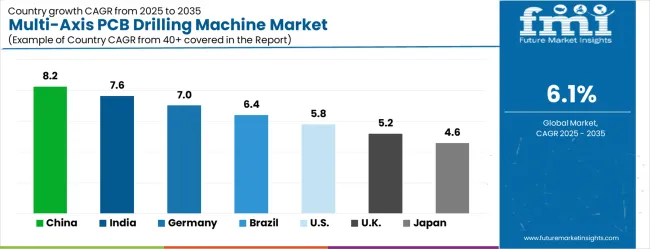
| Country | CAGR (2025-2035) |
|---|---|
| China | 8.2% |
| India | 7.6% |
| Germany | 7.0% |
| Brazil | 6.4% |
| USA | 5.8% |
| UK | 5.2% |
| Japan | 4.6% |
The multi-axis PCB drilling machine market is experiencing strong growth globally, with China leading at an 8.2% CAGR through 2035, driven by the expanding electronics manufacturing industry, growing export capabilities, and significant investment in advanced manufacturing infrastructure development. India follows at 7.6%, supported by large-scale electronics production, emerging drilling facilities, and growing domestic demand for precision manufacturing equipment. Germany shows growth at 7.0%, emphasizing technological innovation and premium equipment development. Brazil records 6.4%, focusing on electronics manufacturing expansion and industrial modernization. The USA demonstrates 5.8% growth, prioritizing advanced manufacturing technologies and high-precision equipment supply. The UK exhibits 5.2% growth, emphasizing electronics manufacturing capabilities and quality drilling equipment adoption. Japan shows 4.6% growth, supported by precision manufacturing excellence and advanced drilling technology innovation.
The report covers an in-depth analysis of 40+ countries with top-performing countries highlighted below.
Revenue from multi-axis PCB drilling machines in China is projected to exhibit exceptional growth with a CAGR of 8.2% through 2035, driven by expanding electronics manufacturing infrastructure and rapidly growing production capabilities supported by government industrial modernization initiatives. The country's abundant electronics manufacturing capacity and increasing investment in precision drilling technology are creating substantial demand for advanced manufacturing solutions. Major electronics companies and manufacturing cooperatives are establishing comprehensive drilling capabilities to serve both domestic and international markets.
Demand for multi-axis PCB drilling machines in India is expanding at a CAGR of 7.6%, supported by the country's growing electronics manufacturing capacity, emerging precision equipment facilities, and increasing domestic demand for advanced manufacturing technologies and drilling solutions. The country's developing electronics supply chain and growing manufacturing industry are driving demand for sophisticated drilling capabilities. International technology providers and domestic manufacturers are establishing extensive production and distribution capabilities to address the growing demand for multi-axis drilling equipment.
The multi-axis PCB drilling machine market in Germany is forecasted to grow at a CAGR of 7.0%, supported by the country's advanced manufacturing industry, strong emphasis on technological innovation, and robust demand for precision equipment among quality-focused manufacturers. The nation's mature electronics manufacturing sector and high adoption of advanced production technologies are driving sophisticated drilling capabilities throughout the supply chain. Leading manufacturers and technology providers are investing extensively in premium equipment development and advanced drilling methods to serve both domestic and export markets.
Sales of multi-axis PCB drilling machines in Brazil is growing at a CAGR of 6.4%, driven by expanding electronics manufacturing infrastructure, increasing industrial modernization patterns, and growing investment in advanced manufacturing technology development. The country's developing industrial resources and modernization of manufacturing facilities are supporting demand for advanced drilling technologies across major production regions. Electronics manufacturers and industrial companies are establishing comprehensive capabilities to serve both domestic industrial centers and emerging export markets.
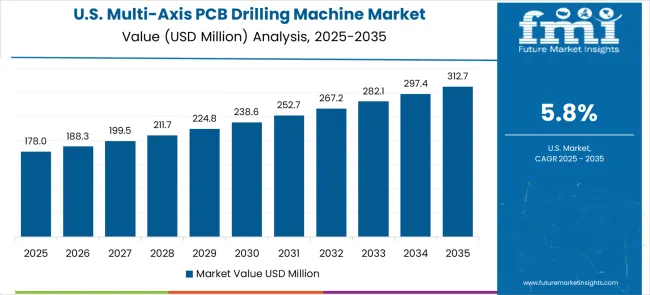
Revenue from multi-axis PCB drilling machines in the USA is forecasted to grow at a CAGR of 5.8%, supported by the country's advanced electronics manufacturing industry, emphasis on high-precision equipment supply, and strong demand for sophisticated manufacturing solutions among technology-focused companies. The USA's established manufacturing sector and technological expertise are supporting investment in advanced drilling capabilities throughout major production centers. Industry leaders are establishing comprehensive quality management systems to serve both domestic and export markets with premium drilling equipment solutions.
Demand for multi-axis PCB drilling machines in the UK is set to expand at a CAGR of 5.2%, driven by the country's electronics manufacturing industry, emphasis on quality equipment adoption, and strong demand for precision manufacturing solutions among established producers. The UK's mature manufacturing sector and focus on technological excellence are supporting investment in advanced drilling capabilities throughout major industrial centers. Manufacturing companies are establishing comprehensive equipment systems to serve both domestic and international markets with quality drilling solutions.
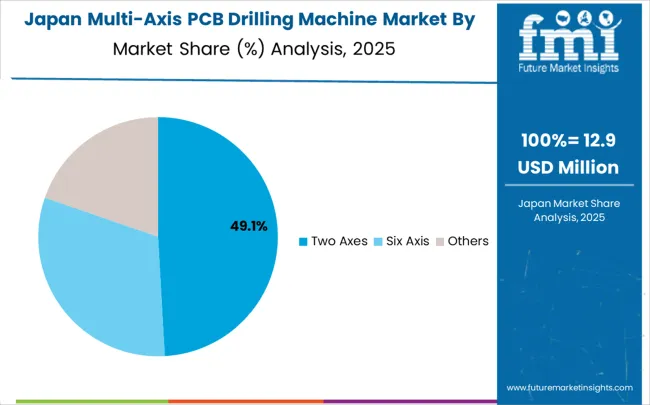
Revenue from multi-axis PCB drilling machines in Japan is anticipated to expand at a CAGR of 4.6%, supported by the country's focus on precision manufacturing excellence, advanced drilling applications, and strong preference for high-quality manufacturing equipment. Japan's sophisticated electronics manufacturing industry and emphasis on precision capabilities are driving demand for advanced drilling technologies including multi-axis systems and automated drilling methods. Leading manufacturers are investing in specialized capabilities to serve electronics production, component manufacturing, and precision drilling applications with premium equipment offerings.
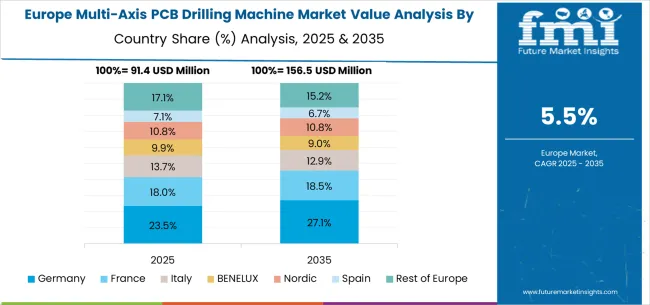
The multi-axis PCB drilling machine market in Europe is projected to grow from USD 82.4 million in 2025 to USD 148.8 million by 2035, registering a CAGR of 6.1% over the forecast period. Germany is expected to maintain its leadership position with a 28.0% market share in 2025, declining slightly to 27.5% by 2035, supported by its strong precision manufacturing industry, advanced drilling facilities, and comprehensive electronics equipment supply network serving major European markets.
France follows with an 18.5% share in 2025, projected to reach 18.8% by 2035, driven by robust demand for multi-axis drilling machines in electronics manufacturing, precision component production, and advanced manufacturing applications, combined with established industrial traditions incorporating advanced drilling equipment. The United Kingdom holds a 16.2% share in 2025, expected to decrease to 15.8% by 2035, supported by strong precision manufacturing demand but facing challenges from competitive pressures and industrial restructuring. Italy commands a 14.0% share in 2025, projected to reach 14.2% by 2035, while Spain accounts for 11.0% in 2025, expected to reach 11.2% by 2035. The Netherlands maintains a 3.5% share in 2025, growing to 3.7% by 2035. The Rest of Europe region, including Nordic countries, Eastern Europe, Portugal, Belgium, Switzerland, and Austria, is anticipated to gain momentum, expanding its collective share from 8.8% to 8.8% by 2035, attributed to increasing adoption of advanced manufacturing equipment in Nordic countries and growing precision manufacturing activities across Eastern European markets implementing industrial modernization programs.
The multi-axis PCB drilling machine market is characterized by competition among established precision equipment manufacturers, specialized drilling technology providers, and integrated manufacturing solution companies. Companies are investing in advanced drilling technology research, automation system optimization, precision control systems, and comprehensive equipment portfolios to deliver consistent, high-quality, and cost-effective multi-axis drilling solutions. Innovation in multi-axis drilling processes, automation technologies, and AI-integrated systems is central to strengthening market position and competitive advantage.
Han's CNC Technology leads the market with a strong market share, offering comprehensive drilling solutions with a focus on precision manufacturing applications and advanced automation systems. Suzhou Vega Technology provides specialized drilling equipment capabilities with an emphasis on multi-axis systems and manufacturing efficiency. Via Mechanics delivers innovative drilling solutions with a focus on high-speed operation and application versatility. Schmoll Maschinen specializes in precision drilling equipment and advanced manufacturing solutions for electronics markets. Tongtai focuses on drilling technology and integrated manufacturing operations. Ofuna Technology offers specialized multi-axis drilling equipment with emphasis on Asian markets and precision applications.
| Items | Values |
|---|---|
| Quantitative Units (2025) | USD 374.6 million |
| Classification | Two Axes, Six Axis, Others |
| Application | Communication, Computers & Servers, Consumer Electronics, Automotive Electronics, Others |
| Regions Covered | North America, Europe, East Asia, South Asia & Pacific, Latin America, Middle East & Africa |
| Countries Covered | United States, Canada, United Kingdom, Germany, France, China, Japan, South Korea, India, Brazil, Australia and 40+ countries |
| Key Companies Profiled | Han's CNC Technology, Suzhou Vega Technology, Via Mechanics, Schmoll Maschinen, Tongtai, and Ofuna Technology |
| Additional Attributes | Dollar sales by classification and application category, regional demand trends, competitive landscape, technological advancements in drilling systems, automation innovation, precision equipment development, and manufacturing optimization |
The global multi-axis PCB drilling machine market is estimated to be valued at USD 374.6 million in 2025.
The market size for the multi-axis PCB drilling machine market is projected to reach USD 677.2 million by 2035.
The multi-axis PCB drilling machine market is expected to grow at a 6.1% CAGR between 2025 and 2035.
The key product types in multi-axis PCB drilling machine market are two axes, six axis and others.
In terms of application, communication segment to command 42.0% share in the multi-axis PCB drilling machine market in 2025.






Our Research Products

The "Full Research Suite" delivers actionable market intel, deep dives on markets or technologies, so clients act faster, cut risk, and unlock growth.

The Leaderboard benchmarks and ranks top vendors, classifying them as Established Leaders, Leading Challengers, or Disruptors & Challengers.

Locates where complements amplify value and substitutes erode it, forecasting net impact by horizon

We deliver granular, decision-grade intel: market sizing, 5-year forecasts, pricing, adoption, usage, revenue, and operational KPIs—plus competitor tracking, regulation, and value chains—across 60 countries broadly.

Spot the shifts before they hit your P&L. We track inflection points, adoption curves, pricing moves, and ecosystem plays to show where demand is heading, why it is changing, and what to do next across high-growth markets and disruptive tech

Real-time reads of user behavior. We track shifting priorities, perceptions of today’s and next-gen services, and provider experience, then pace how fast tech moves from trial to adoption, blending buyer, consumer, and channel inputs with social signals (#WhySwitch, #UX).

Partner with our analyst team to build a custom report designed around your business priorities. From analysing market trends to assessing competitors or crafting bespoke datasets, we tailor insights to your needs.
Supplier Intelligence
Discovery & Profiling
Capacity & Footprint
Performance & Risk
Compliance & Governance
Commercial Readiness
Who Supplies Whom
Scorecards & Shortlists
Playbooks & Docs
Category Intelligence
Definition & Scope
Demand & Use Cases
Cost Drivers
Market Structure
Supply Chain Map
Trade & Policy
Operating Norms
Deliverables
Buyer Intelligence
Account Basics
Spend & Scope
Procurement Model
Vendor Requirements
Terms & Policies
Entry Strategy
Pain Points & Triggers
Outputs
Pricing Analysis
Benchmarks
Trends
Should-Cost
Indexation
Landed Cost
Commercial Terms
Deliverables
Brand Analysis
Positioning & Value Prop
Share & Presence
Customer Evidence
Go-to-Market
Digital & Reputation
Compliance & Trust
KPIs & Gaps
Outputs
Full Research Suite comprises of:
Market outlook & trends analysis
Interviews & case studies
Strategic recommendations
Vendor profiles & capabilities analysis
5-year forecasts
8 regions and 60+ country-level data splits
Market segment data splits
12 months of continuous data updates
DELIVERED AS:
PDF EXCEL ONLINE
PCB Inspection Microscope Market Size and Share Forecast Outlook 2025 to 2035
PCB Design Software Industry Analysis in Europe Size and Share Forecast Outlook 2025 to 2035
PCB Vision Inspection Equipment for SMT Market Size and Share Forecast Outlook 2025 to 2035
PCB Connector Market Size and Share Forecast Outlook 2025 to 2035
PCB Design Software Market Analysis by Component, Deployment, Application, and Region Through 2035
Rigid-Flex PCB Market Size and Share Forecast Outlook 2025 to 2035
Substrate-like PCB Market Size and Share Forecast Outlook 2025 to 2035
Printed Circuit Board (PCB) Assembly Market Size and Share Forecast Outlook 2025 to 2035
Printed Circuit Boards (PCB) Market Trends - Demand & Forecast 2025 to 2035
Industrial Water Chiller for PCB Market Size and Share Forecast Outlook 2025 to 2035
Machine Glazed Paper Market Size and Share Forecast Outlook 2025 to 2035
Machine Glazed Kraft Paper Market Forecast and Outlook 2025 to 2035
Machine Condition Monitoring Market Size and Share Forecast Outlook 2025 to 2035
Machine Glazed Paper Industry Analysis in Asia Pacific Forecast Outlook 2025 to 2035
Machine Vision Camera Market Size and Share Forecast Outlook 2025 to 2035
Machine Tool Oils Market Size and Share Forecast Outlook 2025 to 2035
Machine Vision System And Services Market Size and Share Forecast Outlook 2025 to 2035
Machine Glazed Paper Industry Analysis in Western Europe Size and Share Forecast Outlook 2025 to 2035
Machine Glazed Paper Industry Analysis in Korea Size and Share Forecast Outlook 2025 to 2035
Machine Glazed Paper Industry Analysis in Japan Size and Share Forecast Outlook 2025 to 2035

Thank you!
You will receive an email from our Business Development Manager. Please be sure to check your SPAM/JUNK folder too.
Chat With
MaRIA